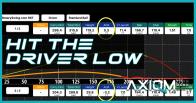Video Menu
My Favorite Videos
My Favorite Videos
How to Hit a Driver Low
Sorry, you need to be a member to access this video.
You Are Just Seconds Away - Become a member here!
Already a member? Log in now

Learn how easy it is to hit a driver low using RST.
the knockdown driver it's one of my favorite shots to hit for students when i at the end of the clinic i always like to demonstrate shots and they ask me to hit draws and cuts and all these things and what's interesting to most of the students is that my swing doesn't really look any different when i go to change any shot whether it's a high draw or a low draw or low cut or whatever all i'm really altering is my left hand and people can't understand that at first until they really get into rst and they realize your hands are really left there in reserve to manipulate ball flight if you choose to do so and your body's really doing 90 of the heavy lifting your arms and hands should be so relaxed throughout the whole swing and through the hitting area that they don't really have to do anything in fact i can almost completely let go of the club and that's kind of one of my visuals is to really get my hands so soft through the hitting area what it feels like is that the club just takes over and does its own thing i don't want to be trying to steer and guide and control it and so when i go to hit a big different shot like that like i hit a ball and the driver 10 feet off the ground my club head speed was still 110 but the ball only carried 204 versus some of the shots you saw earlier which were carrying 284 yards so this is our you know you're hitting off a big elevated tee and you want to roll or you're just trying to get it through the wind my angle of attack changed five degrees there but if you compare it to my other swings they look pretty much the same so how did i go from a positive two and a half degree angle of attack which is my normal driver angle of attack to negative three but the swings look the same well it's simple everything when you're looking at the physics that are involved in the swing and the pushing versus pulling motion that rst harps on that left hand is there to guide and control the club face so all i did to completely change the trajectory the height everything on that shot was this that's it i went from a positive two degree angle of attack to a negative three degree angle of attack just by slightly bowing my left wrist that's all i had to do and because my arms and hands are in reserve they're not the stars of the show they're allowed to start manipulating ball flight like that by making these tiny little finite changes to completely change my ball flight in fact i didn't even change the t position the ball still up in my stance where it normally is but by me just slightly bowing this left wrist all of a sudden the ball changes flights completely so the key here when you start working on your swing you want to make sure that every time you get over a shot your arms and hands are being allowed to be a passenger instead of the star of the show if you get up over the ball and you're all tight and your wrists are tight and i look at your knuckles and they're draining the blood and they're all turning white i know we got a problem it's really critical if you want to become a great ball striker and a master of controlling ball flight your arms and hands have got to be soft so that you can leave them in reserve so that you can manipulate ball flight as you choose to do so on every shot



































































































































































































































































































































































































































































































Mark
Chris (Certified RST Instructor)
Joel
Craig (Certified RST Instructor)
Christian
Chris (Certified RST Instructor)
charles
Craig (Certified RST Instructor)
William
Craig (Certified RST Instructor)
Lance
Craig (Certified RST Instructor)
charles
Craig (Certified RST Instructor)
charles
Craig (Certified RST Instructor)